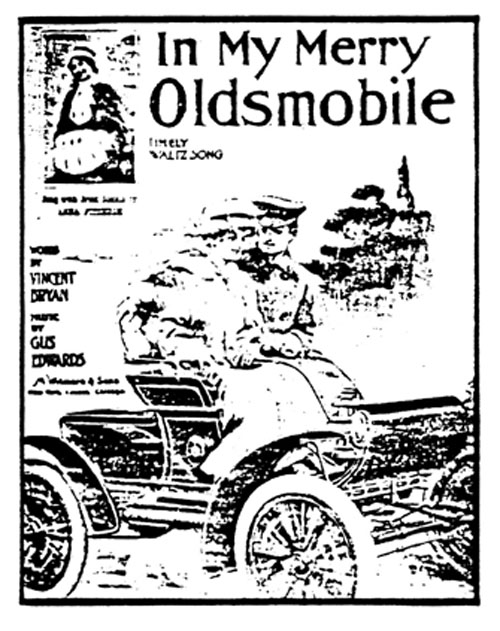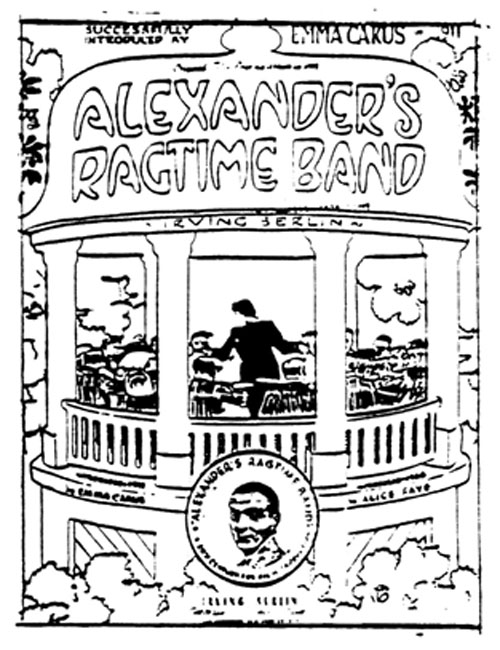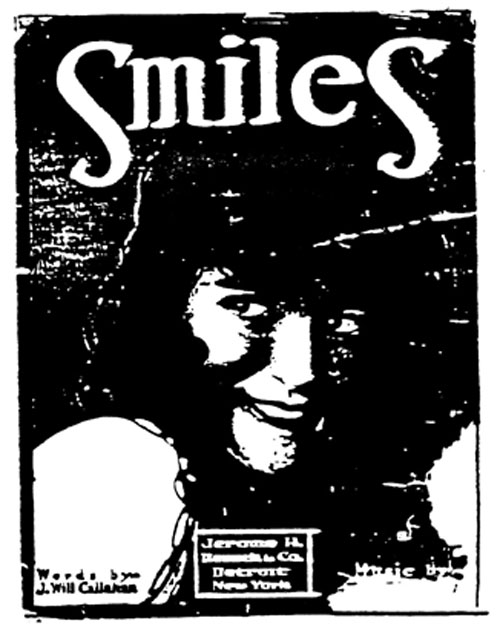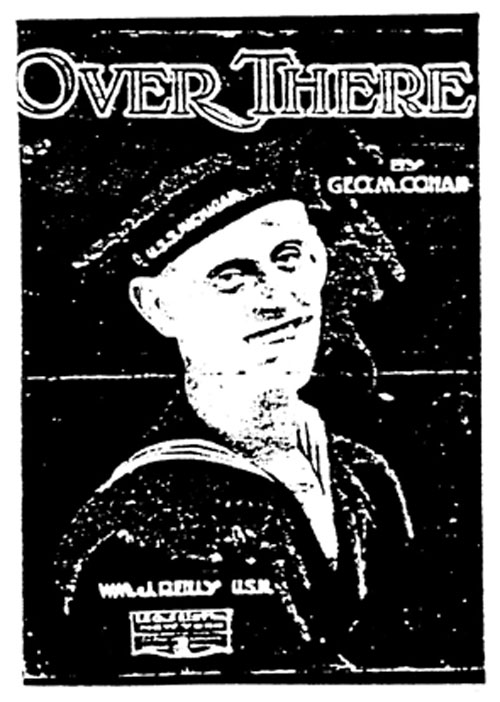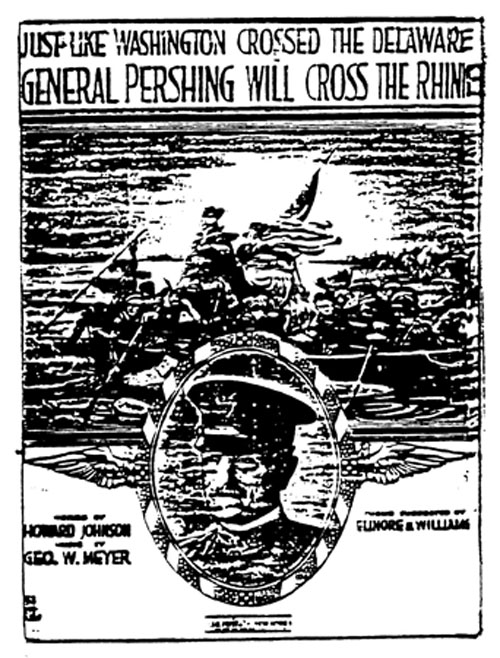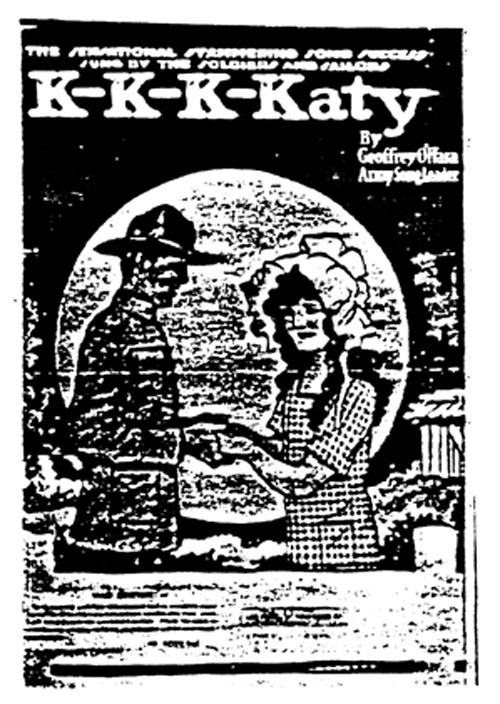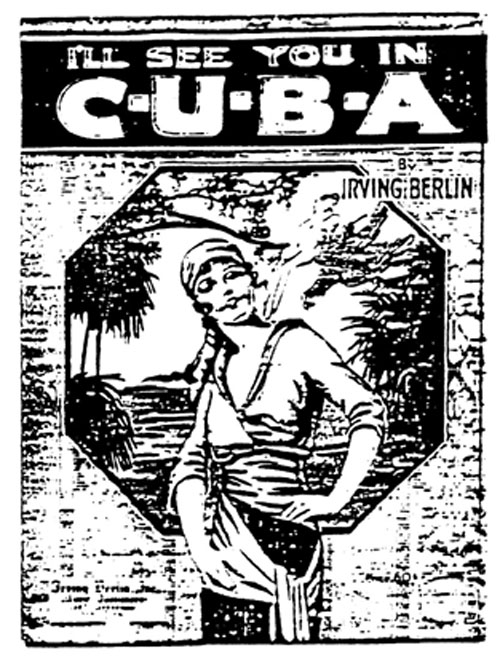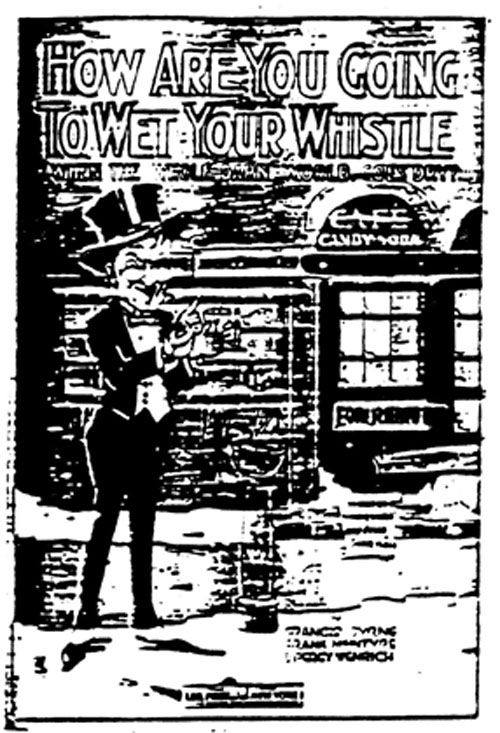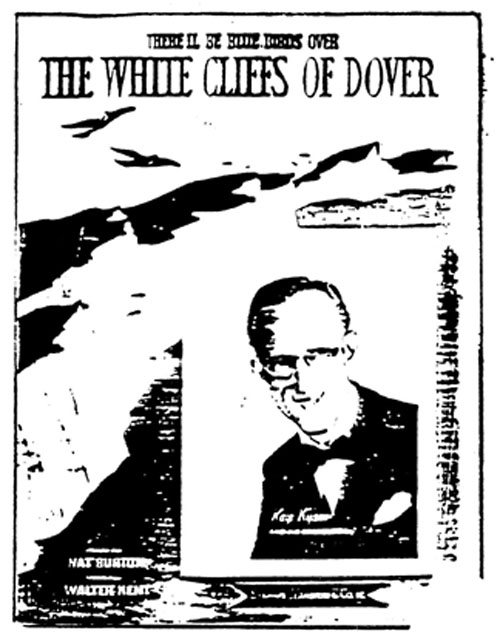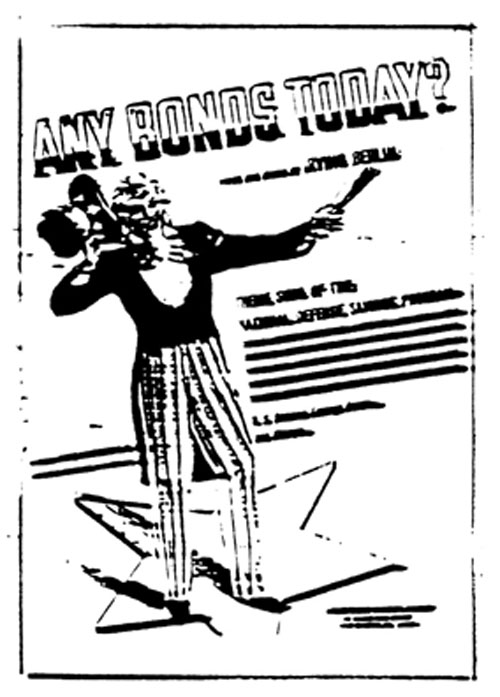|
Home : Quarterly Archives : Volume 28 |
Tredyffrin Easttown Historical Society |
|
Source: October 1990 Volume 28 Number 4, Pages 133–142 Popular Sheet Music : A Reflection of the Times Popular music is an index to the life and history of a nation. Manners, customs, and current events of every generation have been expressed in popular songs. In this article we will look at some of the sheet music that was published during the first half of this century, how this music was popularized, and its relationship to the history of the time. In the early 1900s the focus of music-making and listening was the parlor piano. There were reported to be one million pianos in American homes at that time. (In 1905 the Sears, Roebuck catalogue listed "a grand concert piano" for $165. This was actually a massively built, ornate upright. The same catalogue also offered piano instruction by mail.) Before radio and movies, popular music spread in many ways: traveling shows, music hall productions, circuses, county fairs, and medicine shows. "Amateur nights" in theaters were another way of introducing new songs. Publishers would market their songs in sheet music form, with attractive covers. The early sheet music was about 10-1/2 by 14 inches in size. Beautiful girls or lovely outdoor scenes were pictured on the cover in bright colors. After about 1915 the standard size for sheet music was 9 by 12 inches. The singer or orchestra leader who had successfully introduced the song was often featured on the cover. The cover of a show tune might depict a scene from the show. Another way of promoting popular music developed in the early days of moving pictures when theaters would show several short movies. One way of filling the time between the movies was to have a sing-along. Song publishers made slides of the lyrics to their songs and projected them onto the screen to teach them to the audience. The people then went out and bought the sheet music for the songs they liked, and gathered around the family piano to play and sing them. In the early part of the century, local popular music enthusiasts had to go to Bryn Mawr or Philadelphia to purchase sheet music. Later, Ryner Music stores in Berwyn and Paoli stocked all the popular tunes. The first decade of the 20th century was an easy-going time. The popular songs were happy ones, such as "In the Good Old Summertime" (1902), "Ida! Sweet as Apple Cider!" (1903), "Sweet Adeline" (1903), "School Days"(1907), "Take Me Out to the Ball Game" (1908), "Shine On Harvest Moon"(1908), "By the Light of the Silvery Moon" (1909), "Let Me Call You Sweetheart" (1910), and "Down by the Old Mill Stream" (1910). "Sweet Adeline" became the campaign song for John J. (Honey) Fitzgerald, grandfather of President Kennedy, when he ran for mayor of Boston. It helped elect him to two terms. There is an interesting story connected with "Wait Till the Sun Shines, Nellie" (1905). The idea for the song came from a newspaper article about a New York City family whose problems the journalist solved by the reminder of clearing weather after a storm. After the San Francisco earthquake in 1906 it provided an optimistic chorus for the survivors -- with "Nellie" changed to "Frisco". This was also the time when sentimental songs were popular, including Carrie Jacobs Bond's "Just A-Wearyin' for You" (1901), "I Love You Truly" (1906), and "The End of a Perfect Day" (1910). Hearts were wrung by ballads such as "A Bird in a Gilded Cage". The St. Louis Exposition of 1904 attracted 20 million visitors and inspired the song that nearly everybody sang that year, and which is still popular today, "Meet Me in St. Louis, Meet Me at the Fair". George M. Cohan's songs bubbled over with an American brand of energy and optimism which still has an irresistible appeal: for example, his show tunes "Give My Regards to Broadway" and "Yankee Doodle Boy" from the 1904 musical entitled "Little Johnny Jones". In 1906, "Anchors Aweigh" and Cohan's "You're a Grand Old Flag" expressed the patriotic sentiment of the time. The increasing use of telephones inspired "Hello, Central, Give Me Heaven" in 1901. Pride in other developing technology of this period was also heard in songs like "In My Merry Oldsmobile" (1905) and "Come, Josephine, in My Flying Machine" (1910).
In the second decade of the century Americans went dance mad. The popular dances included the Fox Trot, Turkey Trot, Bunny Hug, Kangaroo Dip, and Grizzly Bear. The Turkey Trot could be danced to Irving Berlin's 1911 "Alexander's Ragtime Band" and "Everybody's Doin' It Now". By this time the dime stores were selling sheet music over their counters, often with a piano player to demonstrate the songs. This direct selling, along with the national dance mania, created a boom in the sheet music business. Light-hearted tunes continued to be popular in the early years of the decade, including "I Want a Girl Just Like the Girl That Married Good Old Dad" (1911), "You Made Me Love You" (1912), "The Sweetheart of Sigma Chi"(1912), "Peg o' My Heart" (1913, revived in 1947), and "When You Wore A Tulip" (1914). The 1912 song "Waiting for the Robert E. Lee" contained much of the spirit of the New Orleans levee and of negro music in general. The song helped to immortalize the Mississippi River steamboats of the old days. By 1915 war had broken out in Europe, and war songs from Europe began to gain popularity. "There's a Long, Long Trail A-Winding", a favorite of the British army, was soon being played and sung in the United States as well. Two other timely English imports were "Keep the Home Fires Burning", which expressed an effective message to civilians, and. "Pack Up Your Troubles", a happy-go-lucky marching song that became popular in this country in spite of its typically English terms, such as "lucifer" for match and "fag" for cigarette. "Roses of Picardy" (1916) and "Bells of St. Mary's" (1917) were also popular imports from England. America's fear of becoming involved in the war was reflected in "I Didn't Raise My Boy to be a Soldier" (1915). Nonetheless, in April of 1917 the United States declared war on Germany; by June U.S. troops were in France; and by October they were in action.
Soon the songs were reflecting, the departure of the American troops for Europe, with titles such as "Goodbye Broadway, Hello France!", "Lorraine - My Beautiful Alsace Lorraine", "When Yankee Doodle Learns to Parlez Vous Francais", "Bing! Bang! Bing 'em on the Rhine", "When Alexander Takes His Ragtime Band to France", "My Belgian Rose", and "Mademoiselle From Armentieres". Popular sentimental songs included "Smiles", "For Me and My Gal", and "Till We Meet Again" which are still sung today, along with several no longer heard, such as "Just A Baby's Prayer at Twilight (For Her Daddy Over There)" and "Three Wonderful Letters from Home" (from the soldier's mother, wife, and baby). The top song of the war was George M. Cohan's "Over There" (1917). Both the words and the music were created for the express purpose of helping the Allies win the First World War. The success of this effort is recognized not only in the lasting popularity of the song, but also in the award of the Congressional Medal to Cohan. In Chester County, Clara L. Baker, a music teacher in West Grove, wrote several patriotic songs which were published and sold throughout the country. In the Chester County Historical Society are autographed copies of many of her compositions, including "We Will Follow Our Flag", "A Light in the Window", "Uncle Sammy's Boys", and "America's Slogan". America's Slogan
We are soldiers, of a country that has never known defeat,
In 1918 "Rose of No Man's Land" expressed the nation's appreciation for Red Cross nurses:
There's a rose that grows in "No Man's Land" Other 1918 songs tended more toward comedy than tragedy, sentiment, or patriotism; for example, "If He Can Fight Like He Can Love, Good Night Germany" or "Just Like Washington Crossed the Delaware, General Pershing Will Cross the Rhine". The latter has a catchy tune, which our family has enjoyed singing over the years, and lyrics particularly appropriate for our area:
Just like Washington crossed the Delaware, The boys in uniform preferred songs that made little or no reference to the war. "K-K-K-Katy" (1918) was very popular with the troops. "How 'Ya Gonna Keep 'Em Down on the Farm After They've Seen Paree?" (1919) was awar song after thought. "The World is Waiting for the Sunrise" (1919) expressed the sentiment of people who were searching for some relief from the sadness of the war years.
The 1920s brought prohibition and women's suffrage; radio was becoming a factor; and where personal behavior was concerned, the sky was the limit! Irving Berlin wrote a hit song in 1920 that took a jibe at prohibition, "I'll See You in C-U-B-A". It had a clever lyric and a tune with a Latin beat.
Not so far from here, there's a very lively atmosphere, "Ain't We Got Fun?" (1921) and "Three O'clock in the Morning" (1922) were perfect theme songs for the Roaring Twenties. Other songs of the decade which reflect the carefree spirits of the time are "Bye, Bye, Blackbird" (1926), "When the Red, Red Robin Comes Bob, Bob, Bobbin' Along" (1926), "Blue Skies" (1927), "Ain't She Sweet" (1927), "You're the Cream in My Coffee" (1928), "Singin' in the Rain" (1929), and the musical nonsense, song "Yes! We Have No Bananas" (1923). This decade saw the most prolific outpouring of song writing in all the decades in Tin Pan Alley history. The good times were reflected in the popularity of jazz bands and in the number of dance bands that were being recorded around the country. The latest addition to the national dance craze was the Charleston, the dance that captivated the nation and defined the defiant spirit of the twenties. The big news of 1927 was Lindbergh's solo flight across the Atlantic, and America's songwriters celebrated it in more than a hundred songs. They're not well-known today, but some of you may recall "Lucky Lindy" and "Lindbergh, the Eagle of the U.S.A." (I haven't the sheet music for either of them, but we still play "Lucky Lindy" on the wind-up Victrola that once belonged to my grandparents.) In this same year Bing Crosby was one of the Rhythm Boys in Paul Whiteman's band, and Al Jolson's film "The Jazz Singer" was the beginning of the "talkies". The optimistic "Happy Days Are Here Again" was written for a motion picture in 1929. It later became the popular theme song for Franklin Roosevelt during his presidential campaigns. The financial depression hit in the fall of 1929, but the talented people turning out words and tunes of consistently high quality helped the country face this period with popular music. The singing and dancing went on, but the tempo became somewhat subdued. The frenzy of the Charleston, Black Bottom, and Varsity Drag was replaced by the smoother Fox Trot and the beat of "sweet jazz". By the 1930s, radio had become an important force in the popular music industry. Records, stage and screen were also instrumental in making the new songs known to a growing public. Movies, now able to present both dancing and singing, were using thousands of songs, both old and new. The tuneful dream world of film musicals offered an escape from the drab and harsh realities of the lean years. Big bands and Broadway musicals were the rage. All these diversions helped the people forget the woes of the Depression, at least for a little while. The best known song that expressed the spirit of the Depression was "Brother, Can You Spare a Dime?"
They used to tell me I was building a dream By 1938 radio's "Hit Parade" and films brought new popularity to older songs, such as "Alexander's Ragtime Band", as well as the current favorites. Walt Disney's full-length cartoon feature "Snow White" introduced "Whistle While You Work", "Heigh Ho", and "Some Day My Prince Will Come".
Kate Smith's radio program was a popular feature in the 1930s. On Armistice Day, 1938, she introduced Irving Berlin's "God Bless America" on her show. By the 1940s the world was at war again. In 1941 "The White Cliffs of Dover" described England's courageous defiance of the Nazi bombings:
I'll never forget the people I met braving those angry skies. Other songs describing conditions of this latest war included "Praise the Lord and Pass the Ammunition"; "When the Lights Go On Again All Over the World", which referred to the blackouts that many countries were experiencing; "Don't Sit Under the Apple Tree With Anyone Else But Me (Till I Come Marching Home)"; "Coming in on a Wing and a Prayeru , which reflected the increasing use of airplanes in combat; "Goodbye, Mama, I'm Off to Yokohama"; "There's A Star-Spangled Banner Waving Somewhere"; and "We Did It Before and We Can Do It Again". In the Chester County Historical Society is a pristine copy of Irving Berlin's "Any Bonds Today?", written to assist the War Bond drives.
The tall man in the tall hat and the whiskers on his chin
Any bonds today?
Any stamps today? The big sensation of 1942 was a song from the movies, also written by Berlin: "White Christmas". Men in uniform had every reason to long for a "white" or "home" Christmas that year. The sincere statement and singable melody continue to make "White Christmas" the most popular Christmas song each year. Another Berlin contribution was his musical show "This Is the Army", which was sung and acted by men in the active service. Berlin joined the cast, wearing his 1917 army uniform. Descriptive songs were "This Is the Army, Mr. Jones"; ""Oh, How I Hate to Get Up in the Morning", borrowed from the first World War; and "I Left My Heart at the Stage Door Canteen". "Li1i Marlene", a song loved by German soldiers, became a favorite with the allied armies as well. Several popular songs of 1944 spoke of the longing of people separated by war, among them "I'll Be Seeing You" and "I'll Walk Alone". Frank Sinatra's hit records of these songs sent people hurrying to their music stores to purchase the sheet music too. In 1945 tributes to the returning servicemen were implied by such songs as "It's Been a Long, Long Time" and "I'm Gonna Love That Guy (Like He's Never Been Loved Before)". After the war was over, novelty songs again were popular, such as "Shoo-Fly Pie and Apple Pan Dowdy" and "Mairzy Doats", which, unscrambled, simply announced that "mares eat oats and does eat oats, and little lambs eat ivy". Irving Berlin's 1946 musical comedy "Annie Get Your Gun." introduced both ballads and novelty songs: "The Girl That I Marry"; "They Say It's Wonderful"; "Doin' What Comes Naturally"; "I Got the Sun in the Morning"; and "Anything You Can Do I Can Do Better". We will end this survey of popular sheet music at mid-century, the beginning of the rock and roll era. Popular music was originally created for adults who went to vaudeville shows, theaters, and night clubs, and who bought sheet music to play and sing. With the advent of rock, most popular music was written for teenagers who now had enough money to buy records. The popular songs from the first half of the 20th century are still loved by people who like to gather around the piano and sing; and perhaps they reminisce about happy times, as well as hard times, that were reflected in the songs and made a bit easier by music. TopSources I used the following sources in writing this article. The books and the Smithsonian record album are available in the local libraries. Collections Sheet music collection of Vera Coleman Egertson Over 300 popular songs collected by a young lady in a small Iowatown from 1900 through the 1940s, the majority between 1915 and 1930 Sheet music collection : Chester County Historical Society Books Best Loved Songs of the American People, Denes Agay A History of Popular Music in America, Sigmund Spaeth 100 Best Songs of the 20s and 30s (Complete words and music) Tin Pan Alley : The Composers, the Songs, the Performers, Their Times, David A. Jasen Record Album American Popular Songs : Six Decades of Songwriters and Singers The Smithsonian Collection of Recordings Recordings from 1910 to the 1960s; 110 songs on seven records plus a descriptive booklet |
